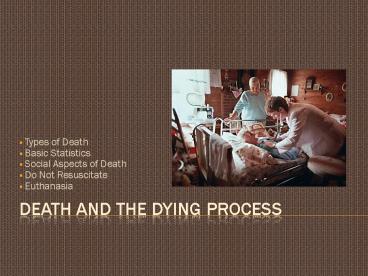Death and the Dying Process - PowerPoint PPT Presentation
1 / 15
Title:
Death and the Dying Process
Description:
Types of Death Basic Statistics Social Aspects of Death Do Not Resuscitate Euthanasia Thanatologists: People who study death and dying. Two types of death: Functional ... – PowerPoint PPT presentation
Number of Views:700
Avg rating:3.0/5.0
Title: Death and the Dying Process
1
Death and the Dying Process
- Types of Death
- Basic Statistics
- Social Aspects of Death
- Do Not Resuscitate
- Euthanasia
2
Types of Death
- Thanatologists People who study death and dying.
- Two types of death
- Functional Death
- Absence of a heart-beat and breathing.
- Brain Death
- Diagnosis of death based on the cessation of all
signs of brain activity. - Measured by electrical brain waves.
3
Basic Statistics
- America has a very high infant mortality rate
- Ranks behind 35 other countries
- Why is this?
- Accurate statistics on our part.
- More drug use than almost any other country.
- In early adulthood the leading cause of death is
accidents. - Followed by Suicide, Homicide, AIDS, and Cancer
4
(No Transcript)
5
Basic Statistics
6
(No Transcript)
7
Social Aspects of Death
- Elisabeth Kubler-Ross
- Based on her observations, she suggested that
people pass through five basic steps as they move
toward death.
8
Social Aspects of Death
- 1. Denial People resist the idea that they are
going to die. - A patient can flatly reject the diagnosis or
request a second opinion. - Sometimes memories of weeks in the hospital
- are forgotten.
- 2. Anger
- They can be angry at people who are in good
health, their spouses and other family, those who
are caring for them, and their children. - Questions Asked Why are the bad people not dying
and why am I? This can lead to the next stage.
9
Social Aspects of Death
- 3. Bargaining Dying people try to negotiate
their way out of death. - If you are good, you will be rewarded
- The reward for being good is to live
- 4. Depression They become overwhelmed with a
sense of loss. - Reactive depression Based on events that have
already occurred. - Loss of dignity that may accompany medical
procedures - End of a job
- Knowledge that one will never return from the
hospital. - Preparatory depression Sadness over future
losses. - Death will bring an end to their relationships.
10
Social Aspects of Death
- 5. Acceptance Final stage of dying is
acceptance. - Once acceptance has arrived they are fully aware
that death is impending. - They will have virtually no feelings,
- positive or negative, about the present or
future. - Denial and isolation It cant be!
- Anger Why me?
- Bargaining Just let me do this first!
- Depression withdrawal, crying, and grieving
- Acceptance a sense of peace comes
11
Do Not Resuscitate
- No-Code Order
- Written order from a doctor that resuscitation
should not be attempted if a person suffers
cardiac or respiratory arrest. - DNR is more commonly done when a person who has
an inevitably fatal illness wishes to have a more
natural death without painful or invasive medical
procedures. - DNR order came into being in the U.S. in the
1960s when defibrillation allowed the reversal of
cardiac arrest.
12
Euthanasia
- Defined The practice of assisting people who are
terminally ill to die more quickly. - There are three types of euthanasia
- 1. Passive Euthanasia
- Withholding common treatments (Antibiotics,
drugs, or surgery) or giving a medication
(Morphine) to relieve pain, knowing that it may
also result in death. - Passive euthanasia is currently the most accepted
form as it is currently common practice in most
hospitals. - 2. Non-aggressive Euthanasia The practice of
withdrawing life support - Quite controversial
- 3. Aggressive Euthanasia Using lethal substances
or force to kill - Extremely controversial
- Physician-Assisted Suicide Term for aggressive
voluntary euthanasia.
13
U.S. Denial and Avoidance of Death
Death and Cultural Contexts
- Funeral industry emphasizes lifelike qualities
- Euphemisms softening language for death
- Persistent search for fountain of youth
- Rejection and isolation of aged
- Concept of pleasant and rewarding afterlife
- Medical emphasis prolonging life, not easing
suffering
14
Attitudes Toward Death at Different Points in the
Life Span
A Developmental Perspective of Death
Infant has no concept of death perceptions of
death develop in middle/late childhood even very
young children concerned about separation and loss
Childhood
Develop more abstract concepts of death common
to think they are immune to death
Adolescence
Middle-aged adults fear death more than young
adults or older adults older adults think about
death more
Adulthood
15
Suicide in U.S.
A Developmental Perspective of Death
- Adolescence
- 3rd leading cause of death in ages10-19
- 19 of high school students seriously considered
or tried suicide in last 12 mos
- Adulthood and Aging
- Suicide rates increase in adulthood
- Older adults use more lethal ways, are more
successful - Racial and gender differences exist





![READ⚡[PDF]✔ The Psychosocial Aspects of Death and Dying PowerPoint PPT Presentation](https://s3.amazonaws.com/images.powershow.com/10047419.th0.jpg?_=20240604046)

![❤[READ]❤ Death, Society, and Human Experience PowerPoint PPT Presentation](https://s3.amazonaws.com/images.powershow.com/10047322.th0.jpg?_=20240604101)


![⚡Read✔[PDF] Death, Society, And the Human Experience PowerPoint PPT Presentation](https://s3.amazonaws.com/images.powershow.com/10047325.th0.jpg?_=20240604101)

![⚡[PDF]✔ Death, Society and Human Experience (11th Edition) PowerPoint PPT Presentation](https://s3.amazonaws.com/images.powershow.com/10047324.th0.jpg?_=20240604101)


![READ[PDF] Death Is but a Dream: Finding Hope and Meaning at Life's End PowerPoint PPT Presentation](https://s3.amazonaws.com/images.powershow.com/10086230.th0.jpg?_=20240726109)















